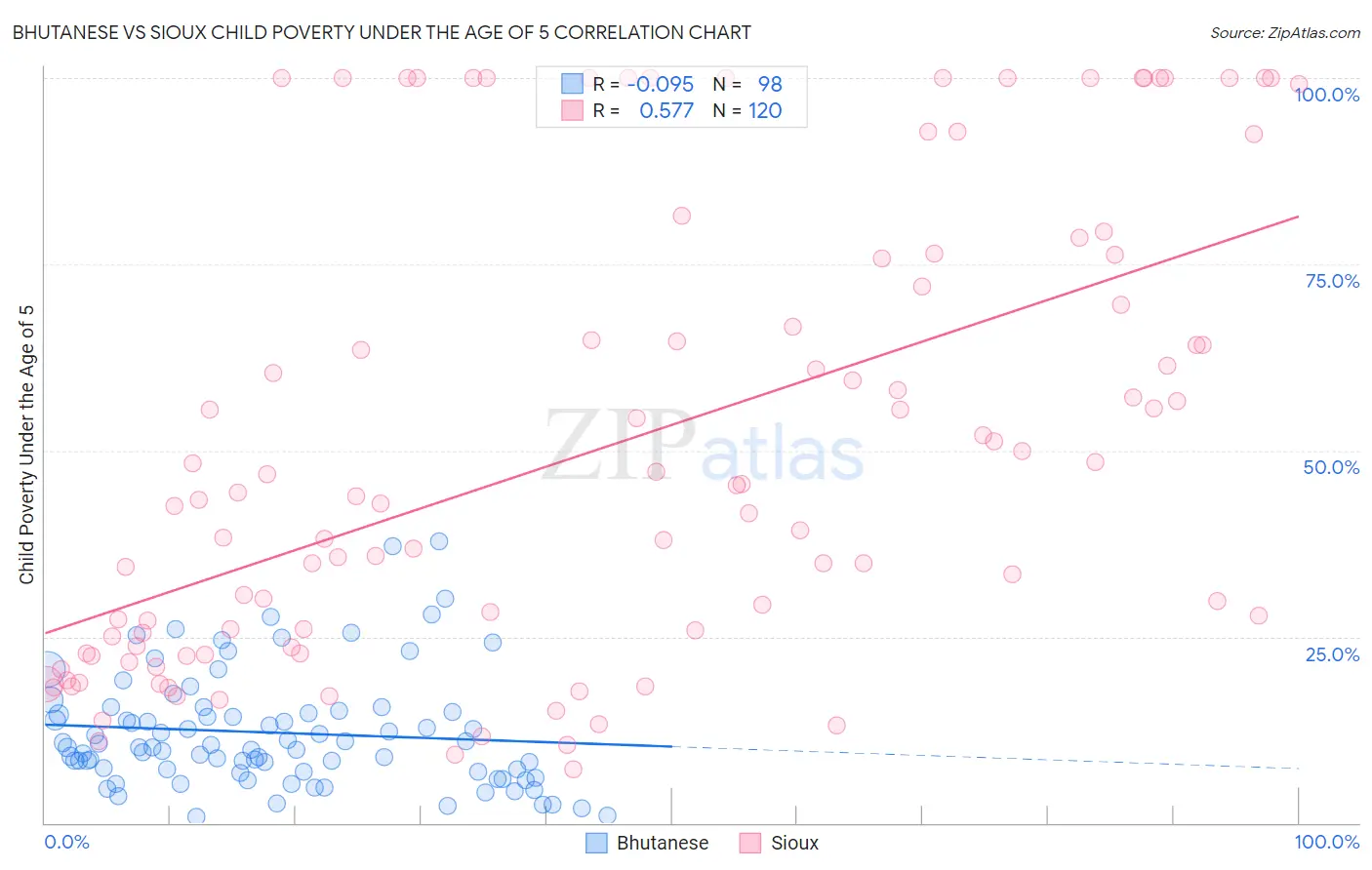Bhutanese vs Sioux Child Poverty Under the Age of 5
COMPARE
Bhutanese
Sioux
Child Poverty Under the Age of 5
Child Poverty Under the Age of 5 Comparison
Bhutanese
Sioux
13.4%
CHILD POVERTY UNDER THE AGE OF 5
100.0/ 100
METRIC RATING
13th/ 347
METRIC RANK
26.9%
CHILD POVERTY UNDER THE AGE OF 5
0.0/ 100
METRIC RATING
336th/ 347
METRIC RANK
Bhutanese vs Sioux Child Poverty Under the Age of 5 Correlation Chart
The statistical analysis conducted on geographies consisting of 434,270,600 people shows a slight negative correlation between the proportion of Bhutanese and poverty level among children under the age of 5 in the United States with a correlation coefficient (R) of -0.095 and weighted average of 13.4%. Similarly, the statistical analysis conducted on geographies consisting of 228,915,867 people shows a substantial positive correlation between the proportion of Sioux and poverty level among children under the age of 5 in the United States with a correlation coefficient (R) of 0.577 and weighted average of 26.9%, a difference of 101.6%.

Child Poverty Under the Age of 5 Correlation Summary
| Measurement | Bhutanese | Sioux |
| Minimum | 0.77% | 7.1% |
| Maximum | 37.8% | 100.0% |
| Range | 37.1% | 92.9% |
| Mean | 12.1% | 50.3% |
| Median | 10.1% | 43.6% |
| Interquartile 25% (IQ1) | 6.9% | 23.7% |
| Interquartile 75% (IQ3) | 14.8% | 73.9% |
| Interquartile Range (IQR) | 7.9% | 50.3% |
| Standard Deviation (Sample) | 7.7% | 30.1% |
| Standard Deviation (Population) | 7.6% | 30.0% |
Similar Demographics by Child Poverty Under the Age of 5
Demographics Similar to Bhutanese by Child Poverty Under the Age of 5
In terms of child poverty under the age of 5, the demographic groups most similar to Bhutanese are Okinawan (13.4%, a difference of 0.65%), Indian (Asian) (13.4%, a difference of 0.70%), Immigrants from South Central Asia (13.3%, a difference of 0.75%), Immigrants from Korea (13.2%, a difference of 0.86%), and Burmese (13.2%, a difference of 0.96%).
| Demographics | Rating | Rank | Child Poverty Under the Age of 5 |
| Immigrants | Singapore | 100.0 /100 | #6 | Exceptional 12.9% |
| Chinese | 100.0 /100 | #7 | Exceptional 13.1% |
| Iranians | 100.0 /100 | #8 | Exceptional 13.1% |
| Immigrants | Iran | 100.0 /100 | #9 | Exceptional 13.1% |
| Burmese | 100.0 /100 | #10 | Exceptional 13.2% |
| Immigrants | Korea | 100.0 /100 | #11 | Exceptional 13.2% |
| Immigrants | South Central Asia | 100.0 /100 | #12 | Exceptional 13.3% |
| Bhutanese | 100.0 /100 | #13 | Exceptional 13.4% |
| Okinawans | 100.0 /100 | #14 | Exceptional 13.4% |
| Indians (Asian) | 100.0 /100 | #15 | Exceptional 13.4% |
| Immigrants | Eastern Asia | 100.0 /100 | #16 | Exceptional 13.5% |
| Assyrians/Chaldeans/Syriacs | 100.0 /100 | #17 | Exceptional 13.6% |
| Immigrants | China | 100.0 /100 | #18 | Exceptional 13.6% |
| Immigrants | Ireland | 100.0 /100 | #19 | Exceptional 13.7% |
| Immigrants | Japan | 100.0 /100 | #20 | Exceptional 13.8% |
Demographics Similar to Sioux by Child Poverty Under the Age of 5
In terms of child poverty under the age of 5, the demographic groups most similar to Sioux are Pima (27.4%, a difference of 1.9%), Hopi (27.7%, a difference of 2.9%), Yup'ik (27.7%, a difference of 3.0%), Black/African American (25.7%, a difference of 4.9%), and Colville (25.7%, a difference of 4.9%).
| Demographics | Rating | Rank | Child Poverty Under the Age of 5 |
| Cajuns | 0.0 /100 | #329 | Tragic 24.1% |
| Creek | 0.0 /100 | #330 | Tragic 24.2% |
| Kiowa | 0.0 /100 | #331 | Tragic 24.5% |
| Apache | 0.0 /100 | #332 | Tragic 25.0% |
| Natives/Alaskans | 0.0 /100 | #333 | Tragic 25.6% |
| Blacks/African Americans | 0.0 /100 | #334 | Tragic 25.7% |
| Colville | 0.0 /100 | #335 | Tragic 25.7% |
| Sioux | 0.0 /100 | #336 | Tragic 26.9% |
| Pima | 0.0 /100 | #337 | Tragic 27.4% |
| Hopi | 0.0 /100 | #338 | Tragic 27.7% |
| Yup'ik | 0.0 /100 | #339 | Tragic 27.7% |
| Cheyenne | 0.0 /100 | #340 | Tragic 28.3% |
| Immigrants | Yemen | 0.0 /100 | #341 | Tragic 29.3% |
| Tohono O'odham | 0.0 /100 | #342 | Tragic 29.5% |
| Yuman | 0.0 /100 | #343 | Tragic 29.5% |